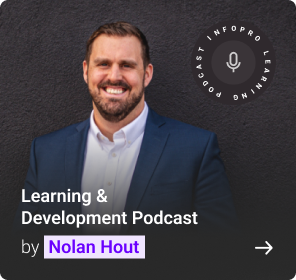Effective training delivery goes beyond simply sharing information; it drives engagement, builds meaningful connections, and fosters real-world performance improvements. While organizations are undergoing thorough and complex change, the focus is now on creating experiences from content that touch the learner much more deeply—thus making it a strategic imperative.
This blog explores how organizations can enhance training delivery to bridge the gap between simply sharing content and fostering meaningful connections that drive engagement, retention, and organizational growth.
The Shift from Content to Connection in Training
The traditional training model is a one-way content orientation, which is no longer relevant for successfully capturing learners’ attention and fails to meet the needs of a new workforce. The 2024 LinkedIn Workplace Learning Report indicates that personalizing learning to a learner’s interests and career goals is one reason learners spend more time learning. This indicates a growing demand for more engaging, context-relevant training programs focusing less on static content.
Therefore, organizations must rethink training to focus on meaningful connections that truly stick. But how do they do it?
Learner-Centric Training Delivery Strategies
1. Personalization and Adaptive Learning Paths
Personalization in training means that learners will receive content aligned with their unique requirements, set goals, and learning styles. Recent developments in advanced data analytics have led to the creation of AI-driven platforms that can quickly track a learner’s behavior and preferences at any time and performance-optimized content that adjusts in real time.
Action Tip: Develop AI-based applications that can provide adaptive learning pathways, allowing each learner to progress as fast or as slowly as they wish and receive content most relevant to their role and goals.
2. Interactive and Experiential Learning
The best training programs involve the learners actively, not passively. Techniques for experiential learning, such as role-playing, simulations, and case studies, allow them to apply what they know in practical scenarios.
Action Tip: Design virtual simulations and in-person workshops that allow learners to practice new skills risk-free.
3. Encouraging Collaboration and Peer-to-Peer Learning
Humans are social creatures and learn from their fellow beings through collaboration and dialogue; they may understand the processes better with improved output. Engaging the workforce with collaborative tools, social platforms, and peer-to-peer programs allows them to share knowledge, collaborate on projects, and solve problems.
Action Tip: Develop communities of practice, discussion forums, and mentoring programs that facilitate continuous dialogue between peers.
4. How to Leverage Microlearning to Have the Greatest Impact
Continuing training over long stretches in today’s era of information overload is impossible. Microlearning provides content in extremely short, bite-sized chunks that focus on one topic at a time and push the information directly into learners’ lives in ways they can apply immediately.
Action Tip: Take an overall module and break it into pieces, each five to ten minutes long, and continue adding videos, infographics, quiz questions, or podcasts for the learners to engage with and maintain focus on.
5. Using Gamification to Enhance Engagement
Gamification taps intrinsic motivators by incorporating game-like features such as rewards, points, and leaderboards into learning. This increases involvement and healthy competition among learners.
Action Tip: Implement gamified features such as challenges, quizzes, and achievement badges to encourage learners to engage more deeply with the content.
6. Measuring Impact and Adjusting for Continuous Improvement
Effective training engagement means outcomes beyond click-through rates, as measures affect realities. Organizations should gather and analyze data that sums up whether the training delivery happens successfully or not or whether the knowledge is retained, applied, or improved for the business.
Action Tip: Use integrated learning management systems with analytics to track key metrics and solicit feedback from learners to grow and improve.
Role of Technology in Relevant Training Interactions
The digital era offers an unparalleled chance to improve training programs. High-tech technologies, such as Artificial Intelligence (AI), Augmented Reality (AR), and Virtual Reality (VR), can associate the theories covered with actual use by creating immersive experiences.
1. Artificial Intelligence and Machine Learning (Machine Learning)
AI and ML tools can offer specially designed learning paths, predict learners’ needs, and automate administrative work, freeing trainees to perform higher-value-added tasks such as discussion leading or mentoring.
2. Augmented Reality and Virtual Reality
AR and VR allow learners to operate in a simulated, controlled training environment and safely attempt new skills without actually exposing themselves to the potential situation being covered. However, this technique is most beneficial to developing hands-on healthcare, engineering, or manufacturing skills.
3. Mobile Learning
Since the nature of work is becoming more mobile and offsite, anytime access to the training material is crucial. Mobile learning platforms offer seamless learning opportunities outside a traditional classroom.
Conclusion
Training delivery from content to connection requires a multifaceted approach, personalization, interaction, collaboration, and technology. Aligning training programs with meaningful learner experiences and tracking the learners’ journeys can help organizations transform training programs into powerful drivers of skills development, employee satisfaction, and business outcomes.
All forward-thinking organizations must invest in training, not just in content, but in creating real connections with learners as a strategic priority for staying competitive and fostering growth in today’s dynamic world.





